If the words “patient-centric” seem odd or foreign to you, they shouldn’t. In fact, you would be well served to emblazon the phrase in gold letters above your front desk and your examination room.

Today’s most successful medical practices have recognized the importance of patient empowerment as a key driver of patient-centered care. And they are tailoring their marketing strategies to boost client engagement, strengthen patient interest and loyalty, and enhance the overall patient experience. In short, for your medical practice to thrive, your patients need to stand front and center at every turn.

Doctors who receive the bulk of their referrals from other physicians are not exempt from the patient-centric process. Patients may receive a referral, but their first action will be to look you up online. If your rating is suspect, patients now control the conversation and can well choose to go somewhere else. What’s more, after visiting your clinic, the first thing they are most likely to do is post a review online. In short, you can make the circle work for you, or against you.
Many physicians balk at the thought of promoting themselves through marketing and advertising. For older physicians, self-promotion was considered a four-letter word since advertising was banned in the American Medical Association (AMA) code of ethics until 1975.
However, the effects of the AMA ban on advertising can still be felt today, especially when those physicians plastering their photos on the sides of buses may be the least qualified or desirable in town! Which underscores the importance of experienced and skilled doctors promoting themselves. If you don’t get the word out about your practice, what choices are you leaving potential patients?
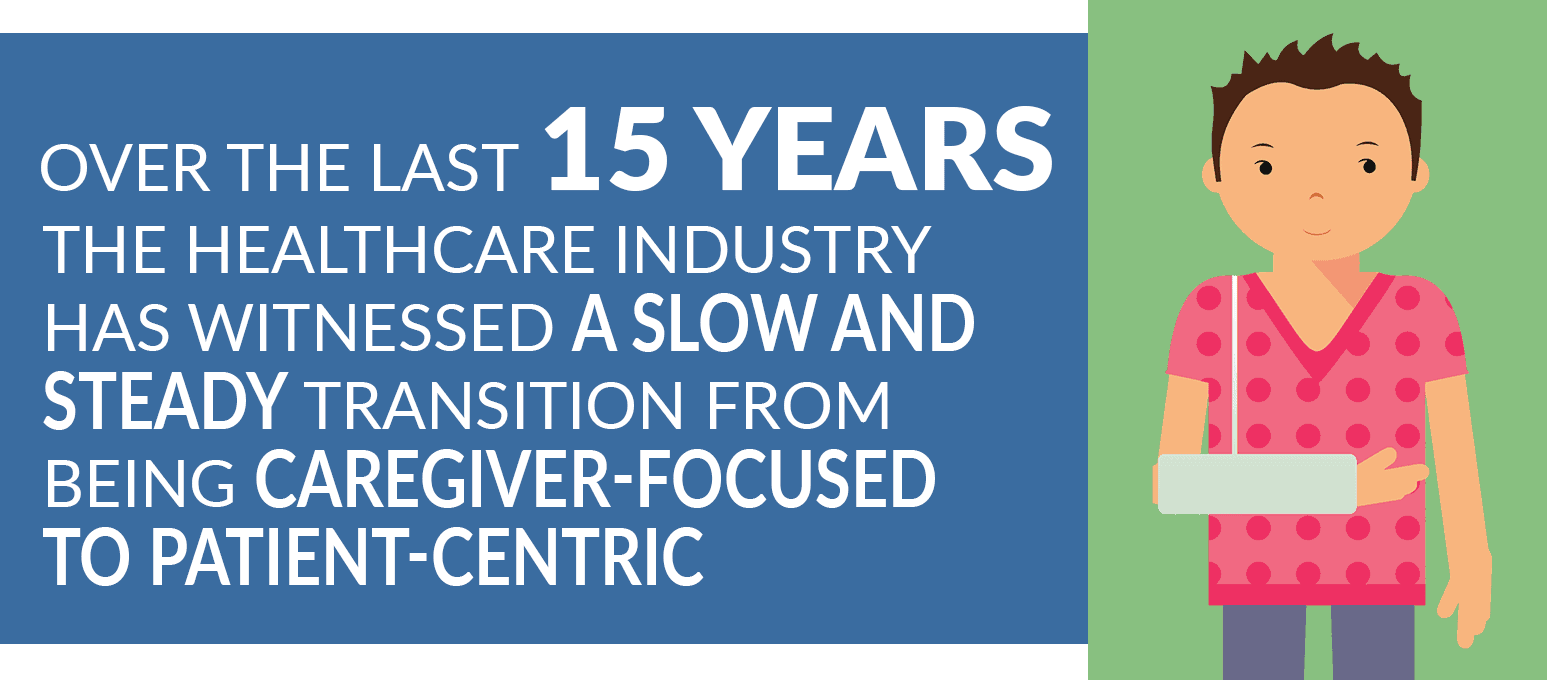
Over the last 15 years, the healthcare industry has witnessed a slow and steady transition from being caregiver-focused to patient-centric.
With new networking technology and increased smart solutions, it can be a rude wake-up call for physicians to realize that treatment is no longer the sole objective of healthcare.
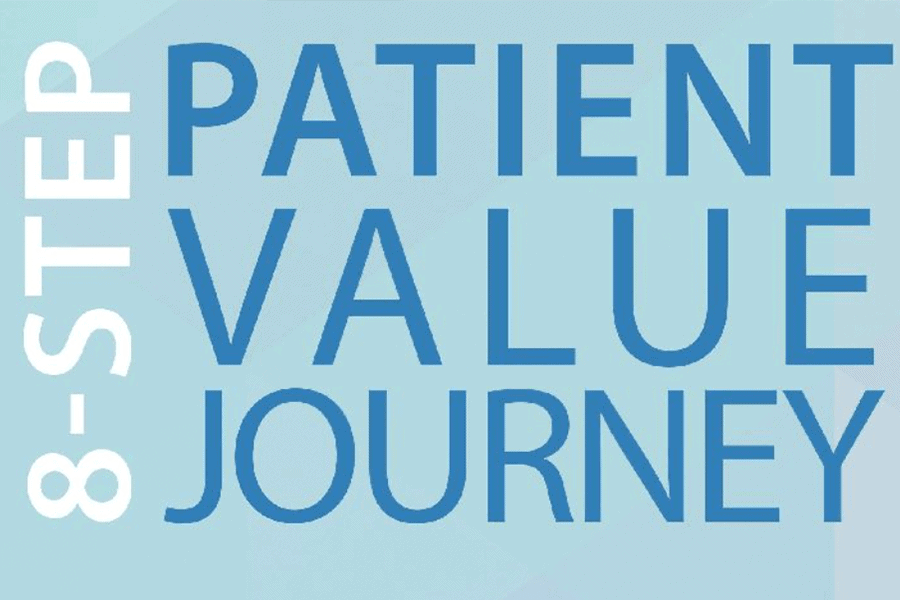
Your patient’s journey begins before they set foot in your office, and comes to an end well after the treatment you provide. The patient experience is shaped by a combination of the content and information accessible online, the ease with which they found it, and the way they shared their experience afterward with their friends and networks.
One thing is certain: healthcare has changed — and you need to decide whether you want to be proactive or reactive. Below we’ll outline five ways you can make your practice more patient-centric, and reap the all the benefits that go along with it.
1. Pay Attention to the Millennial Influence
According to Forbes magazine, the millennial generation is now the largest population segment both in the U.S. and worldwide, outnumbering even the Baby Boomers. This generation has come of age and is leading the way not only in terms of controlling business to consumer (B2C) purchasing power but also having a great influence on business to business (B2B) transactions. These young leaders now control the purse strings of prominent companies and organizations.
What’s more, the values millennials bring to the table have influenced members of both Gen X and the Baby Boom generations. If your medical practice isn’t catering to the needs and values of millennials and their older peers, you can be sure that the practice around the corner is doing just that.
Millennials were the first generation born and brought up with technology. Computers and smartphones played a predominant role in their lives and greatly influenced how they communicate, and they would rather text than talk. If they had to choose between texting and talking on their cell phones, 75% of millennials would rather lose the ability to speak than text. This influence is reflected in society as a whole. 78% of consumers would prefer that businesses offer customer service via text.

Millennials seek instant gratification. They typically expect responses to customer support queries in under ten minutes, not in two business days. Interestingly, millennials also appreciate having self-serve options that give them the ability to find the answers they need on their own. For more and more customers (and patients), however, they equate the level of customer service to how much a company values them.
Perhaps more than any generation, millennials trust reviews. More than 90% of millennials turn to blogs and reviews before making a purchase, and 77% of patients use online reviews as their first step in finding a new doctor. Bottom line: Your online reputation is often the first impression for many patients. If someone decides to share a negative experience, they might easily discourage others from using a particular brand or healthcare provider.
The key takeaway for your practice?
The needs, values, and expectations of millennials have diffused across the generation spectrum creating an informed, empowered, and savvy patient population. From your website to the content you create, to managing online reviews and ranking on Google, to how you interact with patients before, during and after their visit, it’s critical that you harness it all with a patient-centric approach to marketing your medical practice.
2. Testimonials, Testimonials, and More Testimonials!
At the core of patient-centric marketing is sharing results and benefits right from the patient’s mouth. This first-hand narrative has proven to have the greatest impact on potential patients than any other message you can broadcast. Industry studies have shown that almost half of patients would go out of their insurance network to see a doctor with positive reviews.
Your patients (and their social lives) are on social media, and opportunities abound for them to tell their stories. If a patient has a positive experience with you that they share with their networks and community, it can pay off exponentially for your practice. The same holds true for a mediocre or negative experience with any aspect of your practice (i.e., booking an appointment, parking, the front desk, wait times, nurses, and treatment).
As market-growth consultants dedicated exclusively to independent medical practices, we have found over the years that leading with the patient and leveraging positive experiences can convert more potential patients.
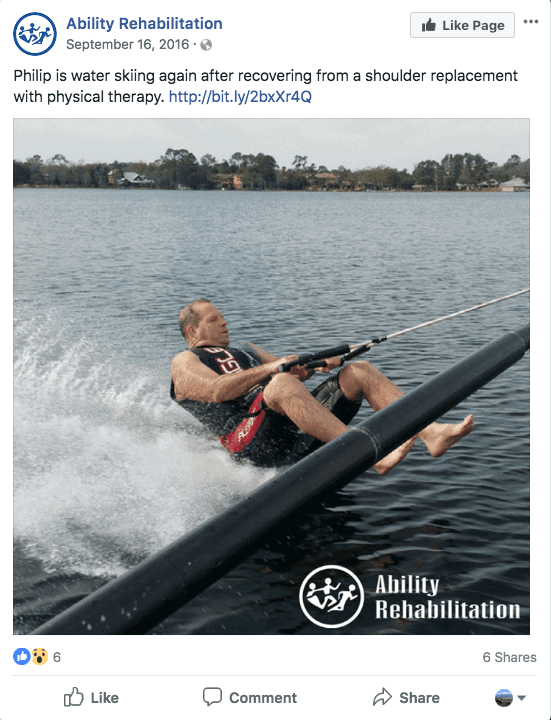 Patients now need and desire an emotional connection with their physician, and before entering into that relationship, they want to learn about others’ experiences with him/her. The majority of visitors to your practice website assume you already have the right credentials. The goal of their website visit is to validate what sets you apart from the rest and how the experience you offer will give them added-value over your competitor around the corner.
Patients now need and desire an emotional connection with their physician, and before entering into that relationship, they want to learn about others’ experiences with him/her. The majority of visitors to your practice website assume you already have the right credentials. The goal of their website visit is to validate what sets you apart from the rest and how the experience you offer will give them added-value over your competitor around the corner.
If your patient proclaims to their community that you were instrumental in changing their life, you have a personal testimonial of tremendous influence, a content piece that will create an immediate bond with prospective patients. That’s a major differentiator for your practice. Moreover, patient testimonials are key tools in effectively managing your online reputation. They can counteract any negative reviews floating in the digital space.
REAL WORLD example:
We work with an orthopedic practice and one spine surgeon, in particular, has created dozens of patient testimonials. Almost every time we film a new testimonial (we create the content in both video and written format) the patient will say that a previous testimonial helped them choose the doctor or tipped the scales in their decision to go ahead and have a procedure performed.
Although there is no direct correlation between video testimonials and number of surgeries, we often hear that a testimonial influenced the patient’s decision. A well-crafted testimonial acts as an introduction, a differentiator from competition, and a qualifier all in one. In just a few minutes a prospective patient can combine a testimonial video with online reviews and perform a complete vetting process of your practice without ever leaving their house.
If we imagine the patient-centric marketing approach as having a checklist, it would include the following:
- Explain the procedure
- Talk about the doctor
- Make the patient feel comfortable
Your goal is to educate prospective patients and then convert them.
The bottom line for your practice: patient-centered content like patient testimonials cultivate trust, connection, credibility, and interest to encourage patients to make an appointment. Your patients will drive your marketing endeavors through word of mouth, from friend to friend, and from network to network.
3. It’s Not About You
It can be easy for a physician to fall into the trap of “I’ve got to market myself, I need to let everyone know I’m the most highly-trained doctor with the most experience and the greatest number of awards. I need people to recall my name when they think of my specialty.”
If you did that, you’d probably see ROI and patient numbers plummet and only one metric rise: your overall advertising budget. We have found time and again with the independent medical practices, we work with that the most successful marketing plans lead with the patient. When larger medical practices created ads in the past, they would have to list every single doctor, every mugshot, and every credential or specialization (often with much internal wrangling on the presentation order based on seniority and ego). The process was inefficient both in terms of ROI, time spent and boosting the awareness of the practice.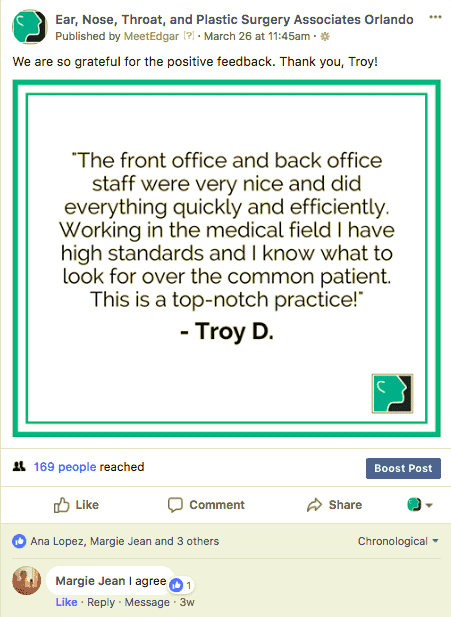
Nowadays, everyone assumes the physicians they are researching are board-certified. All things being equal,
What sets you apart from the rest of the pack will be building trust and accountability, and establishing authority.
Do what patients say about you online reflect the message you are putting out there? If your website declares you’re the greatest doctor in the world, but fifteen reviews are floating online that you have a terrible bedside manner, prospective patients won’t know what to believe.
As a healthcare provider, you can still promote yourself in a way that meshes with a patient-centric strategy. For example, a good “getting to know you” video for a physician will include their credentials, but the heart of the video will be about telling your story, and about creating a personal connection with a potential patient. You can tell your audience about your life experience such as where you’re from and what brought you to study medicine. You might share some tidbits about your family and some of your hobbies. Sharing a little about yourself can really resonate with patients and help them transition from being a potential patient to a real one.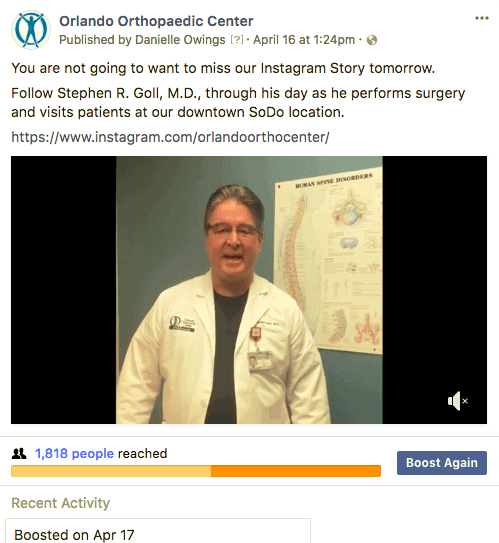
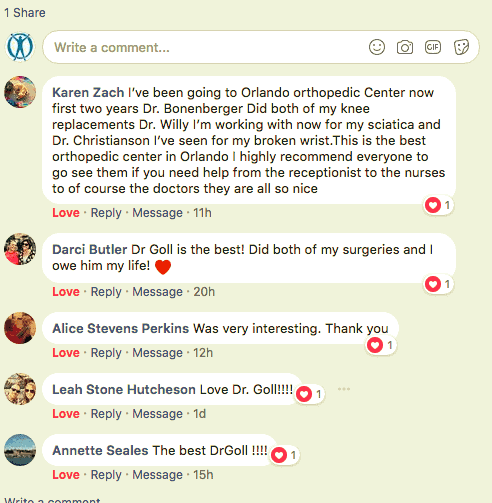
Your patients are your most coveted resource, but they often get neglected. They supply the greatest bang for every marketing dollar you spend. Every doctor has patients that praise the quality of their care. You have patients that will rave about how you helped them get back to doing the things they love most, or for enabling them to live life to the fullest again.
These first-hand accounts provide priceless digital marketing tender that supply endless dividends, endorse you as a credible authority in your subspecialty, and give wings to your practice.
4. Get Social
Healthcare providers are just starting to wake up to this fact: the patient-centric marketing approach is ideally geared and adaptable to Facebook and social media. People already use social media to connect with others, be it friends, peers, and businesses. The visual aspects of patient-focused content lend themselves naturally to platforms like Facebook and Pinterest and give you the opportunity to leverage patient-centric content to your advantage (while staying HIPAA-compliant, of course).

Want to know how? Here are a couple of examples to get you started:
- Take a positive review that you received from Google, RateMDs, or Healthgrades, give it a nice looking background, and post it on social media. Quotes like that work wonders because your existing patients will “Like” it, share it, and post comments such as “Oh, Dr. Jones is my doctor too, and he did this for me.” It’s incredible organic traffic that you can use over and over again. And it won’t cost you a dime.
- Or if a patient comes back into your office for a follow-up visit, have them take a quick photo pose with you. After getting your patient’s consent to share the photo and the procedure, you can post it with the headline “This is Ruth’s last visit, after her knee replacement, and she’s doing great!” Those kinds of posts are wonderful because after Ruth gets home, she will share the post with her family, her Bridge partners, and her whole community.
Leading with the patient on social media doesn’t mean you can’t share details about your doctors, your specialization, or your practice. In fact, with any patient-centric article, quote or video, you can intersperse pertinent information about your physicians, the procedures you offer, and the conditions that you treat.
Social media is about building your community. And one of the best ways to build community is to share stories of your community members and create a space where your fans, audience, and networks can talk about and praise your brand. Don’t be afraid to share successes.
Leading with the patient will increase the reader’s willingness to hear about your credentials and experience, and will bring down the barriers to entry. But you need to establish trust and connection first. Let your patients be your advocates, and the social media floodgates will open.

5. Social Customer Service
The customer (and patient) experience as well as the decision to purchase any good or service has become a social affair. Most people between the ages of 21 and 65 now express their sociability online as well as in real life. Online, how they share their habits on social media and the opinions they offer on review sites demonstrate their eagerness for connection and validation.
This large demographic age group tends to make purchasing decisions collaboratively, and they are not silent and passive consumers. They share their experiences (with products and services). They review, blog and Tumblr, and post Youtube, and Instagram videos. Often their posts involve their consumption activities, interests, and aspirations – things that have impacted their day to day lives.
As mentioned previously, today’s healthcare consumers view the quality of customer service of any business as a direct reflection of how much they are valued. Customers prefer smooth, individualized service that resonates with their needs.
One fertility practice we work with just installed an instant chat system on their website. When a new visitor goes to any page on their site, after a few seconds, the chat notification will pop up. Since installing a little over a week ago, they’ve already had 15+ conversations and scheduled two appointments.
The result: almost twenty fewer phone calls and two potential new patients that may not have converted otherwise. And it cost absolutely nothing to set up. The practice met its patients where and how they wanted to be communicated with, and the benefits flowed in naturally.
Your support team can adapt their support practices to show an increased commitment to and engagement with customer care. Subtle tweaks such as including a friendly greeting that addresses the customer by name can make a big difference. A warmer and more personal attitude not only humanizes your practice (a place that most people wouldn’t choose to go) but also sets the tone for the relationship.
Having some degree of social customer service available (as much as you can provide within HIPAA guidelines) guarantees more exposure for your practice. When you help a patient or announce a practice update on Facebook or Twitter, those interactions are publicly visible. A prospective patient will be able to judge the quality of those exchanges with little to no context.
Customer service has evolved radically during the past decade. Not so long ago, you may have scoffed at the notion of tweeting a company for support. But today, the like of Twitter and Facebook are considered primary customer service channels. Twitter alone has witnessed a 250% increase in customer support interactions in the last two years.
Social customer care is poised to become the order of the day as millennials and their peers dominate the workforce and consumer markets. For you to keep pace, you’ll need to revamp old-school practices and adapt to a more millennial-minded approach. You will need to deliver a convenient, individualized customer support experience and empower your patients to solve problems on their own whenever possible (including the ability to book appointments!).
At the end of the day, if you meet today’s patients on their level, you’ll get them through the front door.
The Bottom Line
Patient-centric care puts the needs of the patient first. The most successful marketing initiatives are those that place prime importance on the patient experience. Doctors need to familiarize themselves with the term healthcare consumerism. Because patients now have more options than ever before, they expect their care to be patient-focused just as they have gotten used to in any customer service sphere.
The great challenge for medical practices (and one they must overcome to be successful) is to transform from the traditional approach of delivering healthcare “their way” to understanding consumer attitudes and behaviors. Doctors need to provide medicine the way patients want it without disrupting the quality of care.
If your practice isn’t maximizing a digital marketing strategy through patient testimonials and online review management, the ship may already have sailed forcing you to play catch-up. Leading with the patient’s positive experience and turning it into a marketing strategy can keep the wind in your sails.










